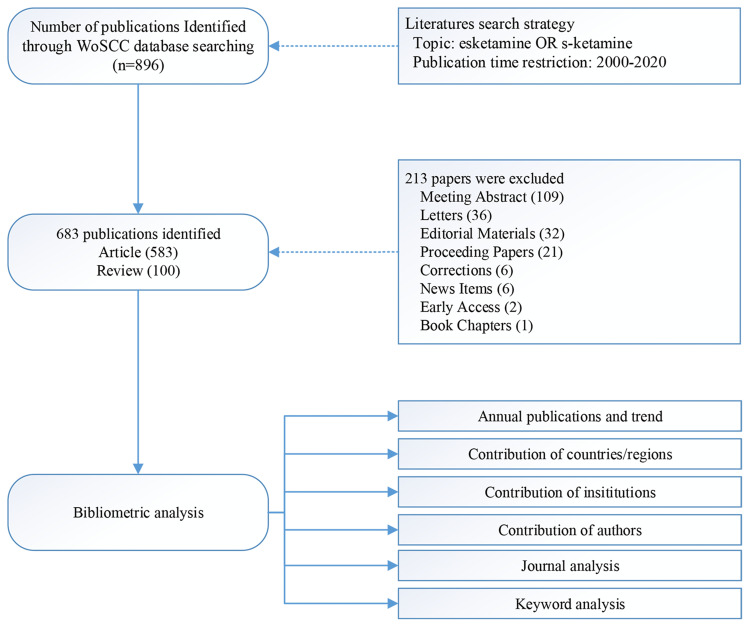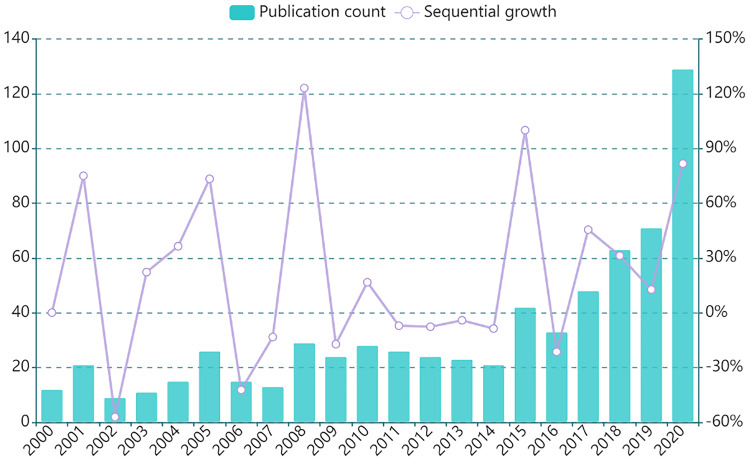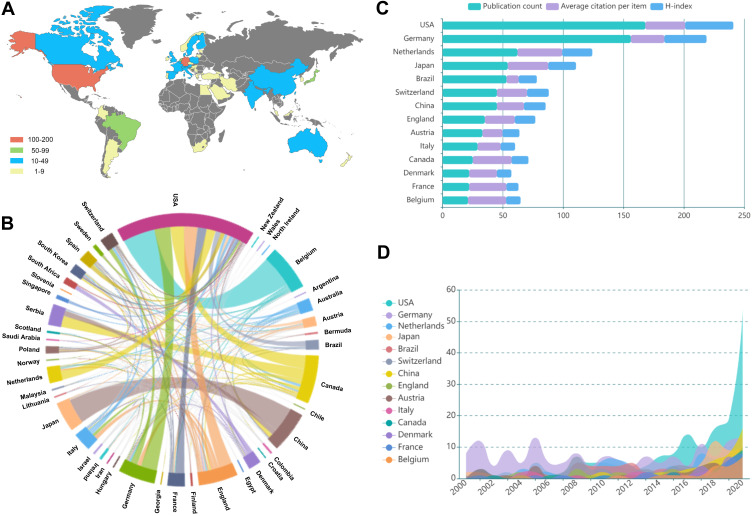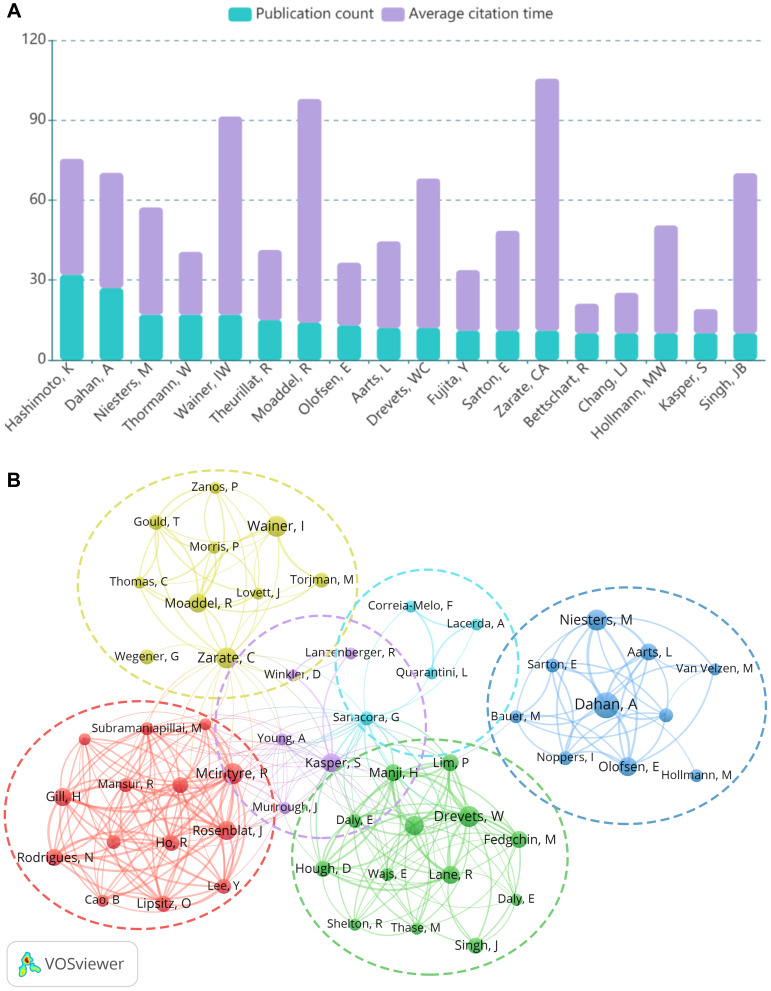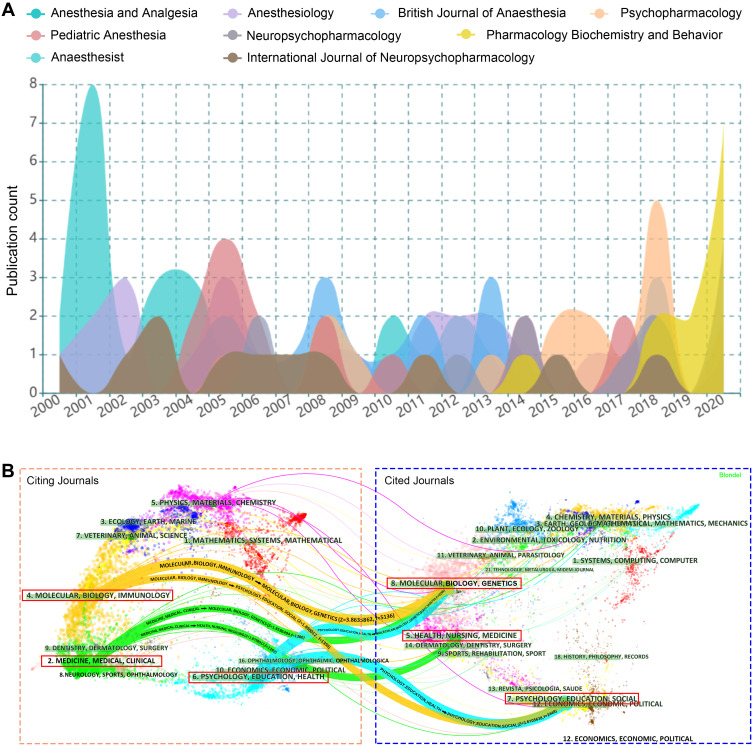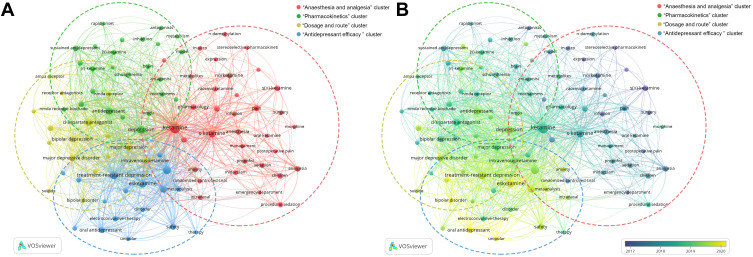Abstract
Background
Being the S-enantiomer of racemic ketamine, esketamine is found to be effective for sedation, analgesia, and treating depression. However, there is no comprehensive bibliometric analysis about esketamine research. In this study, we aimed to determine the scientific output and emerging topics related to esketamine.
Methods
Esketamine-related articles and reviews that published between 2000 and 2020 were obtained from the Web of Science Core Collection database, using key word search of “esketamine” “esketamine hydrochloride”, “s-ketamine”, “S(+)-ketamine”, “(S)-ketamine”, or “(–)-ketamine”. Various bibliographic elements were collected, including the annual number of publications, citation frequency, countries/regions, institutions, authors, journals, and keywords. Two sorts of scientometric software, namely VOS viewer and CiteSpace, were used to conduct bibliometric and knowledge-map analyses.
Results
A total of 683 publications were included in the current study. We found the number of publications in esketamine research field had increased annually since 2016. The United States was the leader in this field, with the highest publications number (162, 23.72%), total citations (3504/9713, 36.08%) and H-index (40). The most productive institution was Chiba University in Japan, and esketamine-related papers were mainly published in the journal Anesthesia & Analgesia. The keyword co-occurrence analysis showed that keywords relevant to depression were the most frequent. Moreover, all identified keywords could be divided into four clusters, with the research focus gradually shifting from cluster of “anesthesia and analgesia detection” to “depression treatment effect.”.
Conclusion
The past two decades have shown a marked increase in esketamine research. The United States maintained a top position worldwide, making the most significant contributions in the field of esketamine research. The contributions and collaborations of Asian countries have continuously increased and is a strong area of growth as well as development in recent years. Additionally, the emerging hotspots of esketamine research concentrate on clarifying its depression treatment effect.
Keywords: ketamine, esketamine, bibliometrics, research trends, depression
Introduction
Esketamine is the S-enantiomer of racemic ketamine and has a greater affinity (approximately two to four-fold) for N-methyl-D-aspartate receptors than the R-enantiomer of ketamine (arketamine). This reduces the required dose and lowers the risk of dose-dependent dissociative symptoms associated with ketamine administration.1 Existing evidence indicates that esketamine has great analgesic and anesthetic activities and is increasingly used for preoperative sedation as well as pain management.2–4 In addition to its analgesic and anesthetic effects, esketamine shows potent antidepressant effects, and the intranasal form of esketamine was approved by the United States Food and Drug Administration in 2019 for the management of treatment-resistant depression in adults.5 Therefore, as an evolutionary drug with various pharmacological effects, the interest in esketamine is increasing.
As one of the most popular mathematical statistics-based approaches, bibliometric analysis can assess academic productivity, summarize academic frontiers and hot spots, and predict scientific development trends in a research field according to scientific literature databases and metrological characteristics. Other approaches, such as traditional review, meta-analysis, or experimental research, are not able to achieve the same depth of analysis.6 In addition, bibliometric analysis can qualitatively and quantitatively estimate the contribution and cooperation of disparate countries or regions, institutions, journals, and authors. To date, bibliometric analyses have been performed to overview cross-sectional and longitudinal scientific productivity in a wide range of medical areas, such as ferroptosis,7 ultrasound microbubbles8 and intestinal organoids.9
In recent years, traditional reviews and meta-analyses have been conducted to systematically examine esketamine research from various aspects.10–12 However, a bibliometric analysis that comprehensively shows the status and trends of this field has not yet been performed. Thus, we aimed to determine general information regarding publications in esketamine research, such as the most productive and influential countries or regions, institutions, authors, and journals, according to the number of publications or citations. The primary aim of this study was to conduct a bibliometric analysis of esketamine research spanning the last two decades (2000–2020) and to help new researchers identify current topics of interests and predict future trends in the esketamine research domain from a global perspective.
Methods
Data Source and Collection
We extracted esketamine-related literature from the Web of Science Core Collection (WoSCC) database published during the past two decades (between 2000 and 2020). The document type was limited to articles and reviews, and the search term was set as “esketamine OR esketamine hydrochloride OR s-ketamine OR S(+)-ketamine OR (S)-ketamine OR (–)-ketamine.” Language restrictions were not imposed as all documents in the WoSCC database had the title, abstract, keywords, and author information written in English. All retrieved records were downloaded in the “plain text” format and the basic information (eg, article title, author, address, abstract, keyword, journal, and publication year) were extracted for further analysis (Figure 1).
Figure 1.
Flow diagram of literature identification.
Data Extraction
Two independent researchers (PX and YD) performed the literature selection and data extraction to ensure the reliability of the results. Elements, including the annual number of publications, citation frequency, countries/regions, institutions, authors, journals, and keywords were extracted and analyzed from the selected articles. Since the journal impact factor (IF) and Journal Citation Reports (JCR) categories were the top reference standards for evaluating journal performance within its field, we retrieved the IF value (2020) and JCR category (2020) for each journal. The H-index, an objective and quantitative indicator for evaluating the scientific output and academic attainment of individuals or research groups,13 was also recorded for each author who contributed to the field of esketamine research.
Data Analysis and Visualization
VOS viewer 1.6.17 (Nees Jan van Eck and Ludo Waltman, Leiden University, Netherlands, downloaded from https://www.vosviewer.com/) is widely used to construct and visualize networks based on scientific publications, scientific journals, researchers, research organizations, countries, or keywords.14 In the current study, we used this software for i) country or region co-authorship analysis, ii) institution co-authorship analysis, iii) author co-authorship analysis, and iv) keyword co-occurrence analysis. In the networks produced by VOS viewer, the node size represents the publication counts, with larger nodes representing a larger number of publications. The links between the nodes indicate correlations between parameters (countries/regions, institutions, authors, or keywords), and the thickness of the links represent their strength. The importance of a node in the network was quantitatively determined by its total link strength (TLS) with other nodes, as previously indicated.8
In addition to VOS viewer, CiteSpace 5.8R1 (Chaomei Chen, Drexel University, United States, downloaded from https://www.citespace.podia.com/) was also used as an important scientometric tool for the analysis of active areas and trends in scientific community research.15 In this study, a dual-map overlay of the type or focus of the journals in esketamine research was constructed and visualized using CiteSpace.
In addition to VOS viewer and CiteSpace, we used Microsoft Excel 2019 (Microsoft Corporation, Redmond, WA, USA) and GraphPad Prism 8.0 (GraphPad Software Inc. San Diego, CA, United States) to conduct data analyses and visualization, such as annual publication counts, citation frequency analysis, and calculation of the average citation time per item for each country, institution, or author.
Results
Annual Publications and Trends
With the retrieval standards mentioned above, a total of 683 eligible publications on esketamine with an overall citation number of 9713 were collected from the WoSCC database encompassing the past two decades (2000–2020). Of these 683 publications, “Article” was the most dominant publication type (85.36%, 583/683, Figure 1); English was the predominant language, constituting 94.30% (644/683) of the total publications; and the most common non-English language was German (3.51%, 24/683).
As shown in Figure 2, the trends in esketamine research fluctuated between 2000 and 2015. From 2016 onward, the number of publications in the field showed an annual upward tendency, and half of the esketamine-related papers (50.4%, 344/683) were published between 2016 and 2020. Notably, the yearly output was nearly twice that of the previous year by 2020.
Figure 2.
Global trends and sequential growth rate of annual publications related to esketamine research from 2000 to 2020.
Contributions of Countries or Regions
There were 48 total countries/regions that published esketamine-related research (Figure 3A). For these countries/regions, 44 were connected to one another for country/region co-authorship analysis. Notably, the United States was at the center of research on esketamine with close collaborations with Belgium and Germany. China and Japan also consistently worked together on esketamine-related research (Figure 3B). Although countries/regions such as Belgium, Canada, and England had relatively low research output, their lines’ strength and count indicated strong connections with other countries and had a great impact on other countries’ research. Of the 48 countries/regions, 14 submitted more than 20 publications. The United States was the most productive and impactful country, with 168 total papers published and an H-index value of 40, while the papers from the Netherlands had the highest average number of citations per item (Figure 3C). Figure 3D displays the annual trends in publication numbers for these 14 countries. Before 2009, Germany published >40% (43.13%) of all studies on esketamine, which was markedly higher than that produced by other countries until it was surpassed by the USA in 2014.
Figure 3.
Contribution of countries/regions to the field of esketamine research. (A) World map displaying the global distribution of esketamine research. Different countries are indicated by different colors based on the number of articles published. (B) Distribution and international cooperation of countries/regions involved in esketamine research. The thickness of the line reflects the frequency of the cooperation; the thicker the line, the stronger the cooperation. (C) The total number of publications counts, average citation per item, and H-index of countries that contributed more than 20 publications in this field. (D) Growth trends in the publication quantity of the countries/regions countries that contributed more than 20 publications in esketamine research from 2000 to 2020.
Contributions of Institutions
A total of 978 distinct institutions were involved in the publication of esketamine research. 15 institutions, most of which were located in the United States (5/15, Figure 4A), published a minimum of 15 papers. Chiba University (Japan) was found to be the most productive institution with 32 papers, followed by the National Institutes of Health (NIH, United States) with 30 papers. On average, papers from the National Institutes of Aging (United States) were cited 66.8 times, which was much higher than the number of citations for other institutions (Figure 4A). Furthermore, 296 links were found among the top 50 most productive institutions in the co-author analysis network (Figure 4B).
Figure 4.
Contribution of institutions in the field of esketamine research. (A) The total number of publications counts, average citation per item, and H-index of institutions that contributed a minimum of 15 papers in this field. (B) Mapping of the co-authorship analysis among top 50 most productive institutions in esketamine research according to VOS viewer. Each node represents an institution, and the node size indicates the number of publications. The connection between the nodes represents a co-authorship relationship, and the thickness of the lines indicates strength (weights on the TLS).
Contribution of Authors
A total of 2952 authors contributed to the research on esketamine, and 18 authors published at least 10 articles (Figure 5A). Kenji Hashimoto from Chiba University (Japan) was the most productive and impactful author in the field of esketamine research, with 32 papers published and an H-index of 18 (Figure 5A). The authors who published at least five papers were included in a network map of authors and were grouped into six clusters. McIntyre (TSL=70), Drevets (TSL=84), Dahan (TSL=70), Zarate (TSL=37), Kaspar (TSL=39), and Sanacora (TSL=44) were separately located at the central position in these clusters (Figure 5B). Most of the active collaborations in esketamine research were among authors in the same cluster, such as Dahan and Niesters (link strength: 15), Dahan and Olofsen (link strength: 12), and McIntyre and Rosenblat (link strength: 12).
Figure 5.
Contribution of authors in the field of esketamine research. (A) The total number of publications counts and average citation per item of authors who contributed at least 10 articles in this field. (B) Mapping of the co-authorship analysis among the authors who published at least five papers on esketamine research according to VOS viewer. Each node represents an institution, and the node size indicates the number of publications. The connection between the nodes represents a co-authorship relationship, and the thickness of the lines indicates strength (weights on the TLS).
Journal Analysis
Overall, 307 journals published research related to esketamine. The top 10 most productive journals published 160 papers on esketamine, accounting for 23.42% of all 683 publications (Table 1). Anesthesia & Analgesia was the most productive journal, publishing 26 papers on ketamine. According to the JCR 2019 standards, most of the top 10 active journals were classified as Q1 or Q2. Moreover, we found that the publications of Anesthesia & Analgesia (22/26, 84.62%) and Pediatric Anesthesia (11/15, 73.33%) were mainly published in 2000–2010, while some journals in psychiatry fields, such as Pharmacology, Biochemistry, and Behavior, Neuropsychopharmacology, and Psychopharmacology, have published studies related to esketamine research since 2018 (Figure 6A). Figure 6B shows a dual-map overlay of the journals on ketamine research. Collectively, there were six main citation paths in the current map. The published studies mainly targeted journals in three fields: i) molecular, biology, and immunology; ii) medicine, medical, and clinical; and iii) psychology, education, and health, whereas the most cited publications originated from the journals of i) molecular biology and genetics; ii) health, nursing, and medicine; and iii) psychology, education, and social.
Table 1.
The Top 10 Journals for Esketamine Research
| Rank | Journal | Publication Count | Impact Factor™ (2020) | Journal Citation Reports ™ 2020 | Total Citations | Average Citation per Item |
|---|---|---|---|---|---|---|
| 1 | Anesthesia and Analgesia | 26 | 5.108 | Q1 | 1232 | 47.38 |
| 2 | Anesthesiology | 25 | 7.892 | Q1 | 1083 | 43.32 |
| 3 | British Journal of Anaesthesia | 19 | 9.166 | Q1 | 579 | 30.47 |
| 4 | Psychopharmacology | 18 | 4.53 | Q2 | 576 | 32 |
| 5 | Pediatric Anesthesia | 15 | 2.556 | Q2/Q3 | 323 | 21.53 |
| 6 | Neuropsychopharmacology | 12 | 7.853 | Q1 | 325 | 27.08 |
| 7 | Pharmacology Biochemistry and Behavior | 12 | 3.533 | Q2/Q3 | 283 | 23.58 |
| 8 | Anaesthesist | 11 | 1.041 | Q4 | 91 | 8.27 |
| 9 | International Journal of Neuropsychopharmacology | 11 | 5.176 | Q1/Q2 | 183 | 16.64 |
| 10 | Veterinary Anaesthesia and Analgesia | 11 | 1.648 | Q2 | 145 | 13.18 |
Figure 6.
Contribution of journals in the field of esketamine research. (A) Growth trends in the publication quantity of the top 10 productive journals in esketamine research from 2000 to 2020. (B) Dual-map overlay of the journals on esketamine research generated by CiteSpace. The labels represent different research subjects covered by the journals. The citing journals are on the left side, while the other side of the map represents the cited journals. Different colored lines correspond to the different paths of references, beginning with the citing map and ending at the cited map. The main citing and cited journals are shown in the red box.
Keyword Analysis
In order to trace the developing trends and hot topics in the field of esketamine research, we performed a keyword co-occurrence analysis using VOS viewer. The results showed a total of 2203 keywords in the 683 papers, and the top 20 most frequent keywords are listed in Table 2. “Ketamine” was the most frequent keyword (258 co-occurrences), which was consistent with our research theme, and keywords relevant to depression accounted for 30% (6/20) (Table 2).
Table 2.
Top 20 Keywords in Occurrence Frequency
| Rank | Keyword | Occurrence | Total Link Strength |
|---|---|---|---|
| 1 | Ketamine | 258 | 1671 |
| 2 | Treatment-resistant depression | 110 | 904 |
| 3 | Double-blind | 104 | 850 |
| 4 | Depression | 104 | 749 |
| 5 | Esketamine | 101 | 756 |
| 6 | s-ketamine | 81 | 551 |
| 7 | Efficacy | 74 | 560 |
| 8 | Antidepressant | 70 | 537 |
| 9 | d-aspartate antagonist | 69 | 603 |
| 10 | Major depression | 54 | 469 |
| 11 | Safety | 41 | 317 |
| 12 | Intravenous ketamine | 40 | 343 |
| 13 | Bipolar depression | 38 | 363 |
| 14 | Oral antidepressant | 35 | 310 |
| 15 | Pain | 35 | 213 |
| 16 | Pharmacology | 33 | 243 |
| 17 | Pharmacokinetics | 32 | 218 |
| 18 | Norketamine | 32 | 208 |
| 19 | Glutamate | 31 | 231 |
| 20 | Anesthesia | 30 | 183 |
As represented in the co-occurrence network (Figure 7A), the identified keywords can be divided into four clusters. The keywords clustered in the red region included the main terms associated with anesthesia and analgesia. Keywords clustered in the green region mainly described the topic of pharmacokinetics. The keywords clustered in the yellow region mainly described the topic of esketamine usage, such as “intranasal esketamine” and “low-dose ketamine.” The keywords clustered in the blue region were mainly related to major depression. The keyword time zone view is shown in Figure 7B, which displays the evolution of high-frequency keywords.
Figure 7.
Contribution of keywords in the field of esketamine research. (A) Keyword co-occurrence analysis on esketamine research using VOS viewer. (B) Overlay visualization of the keyword co-occurrence analysis. The purple nodes represent the keywords appearing earlier, whereas the yellow nodes reflect the recently appearing keywords.
Discussion
This study aimed to determine general information regarding publications in esketamine research, such as the most productive/influential countries/regions, institutions, authors, and journals according to the number of publications or citations. Change in yearly output is commonly indicated as a crucial indicator of the development process in a certain research field.16,17 According to the data obtained from the WoSCC database, a total of 683 articles related to esketamine were published in the past two decades. The development of esketamine research could be divided into two phases, namely “Fluctuation (2000–2015)” and “Stable growth (2016–2020).” In the “Fluctuation” phase, although esketamine gained scientists’ interest, positive growth in publications was only observed in six distinct years (2001, 2003, 2004, 2005, 2008, and 2010), and the average annual rate of publication growth during this stage was 18.06%. However, esketamine research has attracted the attention of researchers and has developed rapidly since 2016. During this “Stable growth” phase, the number of esketamine-related publications experienced a stable and rapid increasing tendency annually, with an average annual rate of publication growth of 42.77%. It was speculated that this explosive growth of publications on esketamine research was partly due to the approval of esketamine for the management of treatment-resistant depression in the United States and Europe.5,18 In general, we predict that the increasing trend in esketamine publications is likely to continue in the years to come.
Regardless of the number of publications or total citation frequency, the United States is a world leader in the field of esketamine research, with Germany ranking second. Interestingly, there were differences between the contributions of these two countries to esketamine research. Germany was the principal contributor to the field of esketamine research in the period of 2000–2010, during which the production from Germany was nearly twice of all publications. Since 2017, the United States has grown to be the most productive country in this field, and the gap between the United States and other countries has gradually increased over the years. Noticeably, other than the United States and Germany, we found that China has also recently emerged as one of the most productive contributors, ranking second in global esketamine publications in the year 2020. This is partly due to the growing interest of Chinese researchers in this area and the increasing financial input into academic research.19 In addition to the total citation number, the average citations per item was also an important indicator of the academic impact and quality of publications for a country.17,20 Our results showed that the ranking of average citations per item was markedly different from the ranking based on publication quantity. Specifically, the Netherlands was the leading country according to average citations per item (37.10), followed by Japan (33.56), the United States (33.00), Canada (32.16), and Belgium (31.62). Several active collaborations were observed among different countries/regions, and most of the collaborations were focused on countries in North America and Europe, such as United States-Belgium, United States-Germany, and United States-England, with the United States being the main collaborating center. Noticeably, we observed active cooperation between China and Japan, implying that esketamine-related research has gained interest worldwide.
The quantity and influence of research institutions is critical to the academic level of a country in a research field.21 All of the top 15 most productive institutions were from developed countries, which implies an important role for economic foundation in supporting scientific research. Chiba University in Japan was the only Asian institution in the top 15 institutions for esketamine research, but it made the highest contribution to global research in terms of the total number of publications. Five of the top 15 institutions in esketamine research were from the United States, with the NIH as the leading institution in terms of both the total number of citations and H-index. Moreover, in the co-authorship analysis of institutions, the top three representative institutions were the University of Toronto, the University Health Network, and the National University of Singapore, and these three institutions worked closely with each other. However, the network map of institution co-authorship analysis implied that most close collaborations occurred between institutions at a relatively low level in esketamine research, and thus, collaborations between institutions with higher academic levels need to be strengthened.
Evaluating the contributions of influential researchers in a certain scientific field can help scholars develop the field with better understanding and novel directions.22 Among the 2952 authors who contributed to esketamine research, Hashimoto from Chiba University who published a total of 32 manuscripts was the most productive author in this field. Zarate published only 11 esketamine-related manuscripts, but the average number of citations per item of his publication (94.64) was higher. Moreover, he was affiliated with the NIH, which also exerts an important influence in the field of esketamine research. In addition, the authors who were located at a central position of the cooperating clusters in the co-authorship analysis were from the institutions in the United States and Europe. Language barriers are considered part of the blocks of international collaboration.23 It is gratifying that a few Asian authors were actively involved in the cooperating clusters in esketamine research, and we hope that their significant academic share could encourage more researchers to devote themselves to this field.
For journals, Anesthesia & Analgesia (IF = 5.108, Q1), Anesthesiology (IF = 7.892, Q1), and the British Journal of Anesthesia (IF = 9.166, Q1) published the most manuscripts related to esketamine. These journals with high IFs and JCR categories may have greater opportunities to attract high-quality papers, and the publication of excellent papers can also improve the academic quality and influence of these journals. Remarkably, the journals focused on esketamine research have gradually moved from the anesthesiology field to the psychiatric field. In addition, dual-map overlays of journals were frequently used in previous bibliometric analyses to illustrate the trends in the scientific portfolio and identify the information flow between journals.7,8 In this study, one of the main citation paths was from Molecular/Biology/Genetics co-cited journals to Molecular/Biology/Immunology citing journals, indicating that esketamine-related studies are concentrated on basic research. Meanwhile, the information flow between Psychology/Education/Social and Molecular/Biology/Immunology suggests that these journals may have an interest in the mechanism of esketamine in the treatment of mental disorders.
In bibliometric analysis, keyword co-occurrence analysis facilitates the estimation of hotspots in a research field, and the time zone view can predict development trends.24 Esketamine has been confirmed as a vital medication in sedation and pain management; thus, the effect of esketamine in anesthesia and analgesia has been a hotspot from the initial stage. With time, it can be observed that the research focus has gradually shifted from “anesthesia and analgesia” to “depression treatment effect.” Meanwhile, the most frequently appearing terms of esketamine in Table 2 included treatment-resistant depression, double-blind, and depression, which in line with the approval of esketamine for the treatment of depression. From the above analysis, we speculate that the future research hotspots in the field of esketamine are related to its anti-depressive effects. Further clinical trials including in-depth experimental research remain ongoing.
Limitations
There were several limitations to the current study. First, we only obtained data from the WoSCC database; thus, publications that were not collected in the WoSCC database were ignored. However, as the WoSCC is considered to be the most commonly applied and recommended database for bibliometric analysis, data included in WoSCC can depict most of the information in a given field.25,26 Second, because of the continuous updating of data in the WoSCC database, the bibliometric analysis results typically fall behind the actual research situation.27,28 Finally, the newly published and potentially influential publications may not have been included in our study due to low citation frequency. Therefore, the understanding and scientific trends of esketamine research may change with time and bibliometric data updates.
Conclusion
Our study is the first to illustrate the present research status and emerging global trends in esketamine research using a bibliometric analysis. Overall, the field of esketamine research is in the rapid development phase, and this area of research is likely to continue to expand rapidly. The United States is undoubtedly the largest contributor and in a principal position in global research. In the meantime, the contributions and collaborations of Asian countries have been continuously promoted in recent years and should not be overlooked. With the focus gradually shifting from “anesthesia and analgesia” to “depression treatment,” the clinical verification of its effects on major depression was the latest research hotspot. In the near future, we predict that promising research directions may concentrate on the molecular mechanism of the antidepressant efficacy of esketamine. Overall, we believe the results of this study would provide helpful references for further research.
Acknowledgments
The authors would like to thank all the reviewers who participated in the review.
Funding Statement
This work was supported by the Precision Medicine Foundation of Guangdong Province Hospital Association (grant number 2020-10).
Data Sharing Statement
The original contributions presented in the study are included in the article; further inquiries can be directed to the corresponding authors.
Ethical Statement
The authors are accountable for all aspects of the work in ensuring that questions related to the accuracy or integrity of any part of the work are appropriately investigated and resolved.
Author Contributions
All authors made a significant contribution to the work reported, whether that is in the conception, study design, execution, acquisition of data, analysis and interpretation, or in all these areas; took part in drafting, revising or critically reviewing the article; gave final approval of the version to be published; have agreed on the journal to which the article has been submitted; and agree to be accountable for all aspects of the work.
Disclosure
The authors declare that the research was conducted in the absence of any commercial or financial relationships that could be construed as a potential conflict of interest.
References
- 1.Swainson J, Thomas RK, Archer S, et al. Esketamine for treatment resistant depression. Expert Rev Neurother. 2019;19(10):899–911. doi: 10.1080/14737175.2019.1640604 [DOI] [PubMed] [Google Scholar]
- 2.Eberl S, Koers L, van Hooft J, et al. The effectiveness of a low-dose esketamine versus an alfentanil adjunct to propofol sedation during endoscopic retrograde cholangiopancreatography: a randomised controlled multicentre trial. Eur J Anaesthesiol. 2020;37(5):394–401. doi: 10.1097/EJA.0000000000001134 [DOI] [PubMed] [Google Scholar]
- 3.Jonkman K, Duma A, Olofsen E, et al. Pharmacokinetics and bioavailability of inhaled esketamine in healthy volunteers. Anesthesiology. 2017;127(4):675–683. doi: 10.1097/ALN.0000000000001798 [DOI] [PubMed] [Google Scholar]
- 4.Wang X, Lin C, Lan L, Liu J. Perioperative intravenous S-ketamine for acute postoperative pain in adults: a systematic review and meta-analysis. J Clin Anesth. 2021;68:110071. doi: 10.1016/j.jclinane.2020.110071 [DOI] [PubMed] [Google Scholar]
- 5.Sapkota A, Khurshid H, Qureshi IA, et al. Efficacy and safety of intranasal esketamine in treatment-resistant depression in adults: a systematic review. Cureus. 2021;13(8):e17352. doi: 10.7759/cureus.17352 [DOI] [PMC free article] [PubMed] [Google Scholar]
- 6.Choudhri AF, Siddiqui A, Khan NR, Cohen HL. Understanding bibliometric parameters and analysis. Radiographics. 2015;35(3):736–746. doi: 10.1148/rg.2015140036 [DOI] [PubMed] [Google Scholar]
- 7.Zhang J, Song L, Xu L, et al. Knowledge domain and emerging trends in ferroptosis research: a bibliometric and knowledge-map analysis. Front Oncol. 2021;11:686726. doi: 10.3389/fonc.2021.686726 [DOI] [PMC free article] [PubMed] [Google Scholar]
- 8.Wu H, Tong L, Wang Y, Yan H, Sun Z. Bibliometric analysis of global research trends on ultrasound microbubble: a quickly developing field. Front Pharmacol. 2021;12:646626. doi: 10.3389/fphar.2021.646626 [DOI] [PMC free article] [PubMed] [Google Scholar]
- 9.Zhang MM, Yang KL, Cui YC, et al. Current trends and research topics regarding intestinal organoids: an overview based on bibliometrics. Front Cell Dev Biol. 2021;9:609452. doi: 10.3389/fcell.2021.609452 [DOI] [PMC free article] [PubMed] [Google Scholar]
- 10.Capuzzi E, Caldiroli A, Capellazzi M, et al. Long-term efficacy of intranasal esketamine in treatment-resistant major depression: a systematic review. Int J Mol Sci. 2021;22(17):9338. doi: 10.3390/ijms22179338 [DOI] [PMC free article] [PubMed] [Google Scholar]
- 11.Molero P, Ramos-Quiroga JA, Martin-Santos R, Calvo-Sanchez E, Gutierrez-Rojas L, Meana JJ. Antidepressant efficacy and tolerability of ketamine and esketamine: a critical review. CNS Drugs. 2018;32(5):411–420. doi: 10.1007/s40263-018-0519-3 [DOI] [PubMed] [Google Scholar]
- 12.Ng J, Rosenblat JD, Lui LMW, et al. Efficacy of ketamine and esketamine on functional outcomes in treatment-resistant depression: a systematic review. J Affect Disord. 2021;293:285–294. doi: 10.1016/j.jad.2021.06.032 [DOI] [PubMed] [Google Scholar]
- 13.Engqvist L, Frommen JG. The h-index and self-citations. Trends Ecol Evol. 2008;23(5):250–252. doi: 10.1016/j.tree.2008.01.009 [DOI] [PubMed] [Google Scholar]
- 14.Antonio Perianes-Rodriguez LW, Eck NJ, van Eck NJ. Constructing bibliometric networks: a comparison between full and fractional counting. J Informetr. 2016;10(4):1178–1195. doi: 10.1016/j.joi.2016.10.006 [DOI] [Google Scholar]
- 15.Chen C, Song M, Glanzel W. Visualizing a field of research: a methodology of systematic scientometric reviews. PLoS One. 2019;14(10):e0223994. doi: 10.1371/journal.pone.0223994 [DOI] [PMC free article] [PubMed] [Google Scholar]
- 16.Qin Y, Zhang Q, Liu Y. Analysis of knowledge bases and research focuses of cerebral ischemia-reperfusion from the perspective of mapping knowledge domain. Brain Res Bull. 2020;156:15–24. doi: 10.1016/j.brainresbull.2019.12.004 [DOI] [PubMed] [Google Scholar]
- 17.Zhang H, Fan Y, Wang R, et al. Research trends and hotspots of high tibial osteotomy in two decades (from 2001 to 2020): a bibliometric analysis. J Orthop Surg Res. 2020;15(1):512. doi: 10.1186/s13018-020-01991-1 [DOI] [PMC free article] [PubMed] [Google Scholar]
- 18.Bahji A, Vazquez GH, Zarate CA. Comparative efficacy of racemic ketamine and esketamine for depression: a systematic review and meta-analysis. J Affect Disord. 2021;278:542–555. doi: 10.1016/j.jad.2020.09.071 [DOI] [PMC free article] [PubMed] [Google Scholar]
- 19.Yeung AW, Goto TK, Leung WK. The changing landscape of neuroscience research, 2006–2015: a bibliometric study. Front Neurosci. 2017;11:120. doi: 10.3389/fnins.2017.00120 [DOI] [PMC free article] [PubMed] [Google Scholar]
- 20.Wang Z, Zhou Z, Xu W, et al. Research status and development trends in the field of marine environment corrosion: a new perspective. Environ Sci Pollut Res Int. 2021;28:54403–54428. doi: 10.1007/s11356-021-15974-0 [DOI] [PubMed] [Google Scholar]
- 21.Zhao H, Liu J, Bao Z, Xu Y, Wang Z. Global research trends in dental stem cells: a bibliometric and visualized study. Tissue Eng Part B Rev. 2021. doi: 10.1089/ten.teb.2021.0080 [DOI] [PubMed] [Google Scholar]
- 22.Kodonas K, Fardi A, Gogos C, Economides N. Scientometric analysis of vital pulp therapy studies. Int Endod J. 2021;54(2):220–230. doi: 10.1111/iej.13422 [DOI] [PubMed] [Google Scholar]
- 23.Gantenbein L, Arora P, Navarini A, Brandt O, Mueller SM. Global publication productivity in dermatology: a bibliometric description of the past and estimation of the future. J Eur Acad Dermatol Venereol. 2021;35(7):1424–1433. doi: 10.1111/jdv.17196 [DOI] [PubMed] [Google Scholar]
- 24.Xiao F, Li C, Sun J, Zhang L. Knowledge domain and emerging trends in organic photovoltaic technology: a scientometric review based on citespace analysis. Front Chem. 2017;5:67. doi: 10.3389/fchem.2017.00067 [DOI] [PMC free article] [PubMed] [Google Scholar]
- 25.Chen P, Du Z, Wang J, Liu Y, Zhang J, Liu D. A bibliometric analysis of the research on hematological tumor microenvironment. Ann Transl Med. 2021;9(16):1337. doi: 10.21037/atm-21-3924 [DOI] [PMC free article] [PubMed] [Google Scholar]
- 26.Ke L, Lu C, Shen R, Lu T, Ma B, Hua Y. Knowledge mapping of drug-induced liver injury: a scientometric investigation (2010–2019). Front Pharmacol. 2020;11:842. doi: 10.3389/fphar.2020.00842 [DOI] [PMC free article] [PubMed] [Google Scholar]
- 27.Liu T, Liu X, Li Y, Liu S, Cao C. Evolving trends and research hotspots in disaster epidemiology from 1985 to 2020: a bibliometric analysis. Front Public Health. 2021;9:720787. doi: 10.3389/fpubh.2021.720787 [DOI] [PMC free article] [PubMed] [Google Scholar]
- 28.Sweileh WM. Substandard and falsified medical products: bibliometric analysis and mapping of scientific research. Global Health. 2021;17(1):114. doi: 10.1186/s12992-021-00766-5 [DOI] [PMC free article] [PubMed] [Google Scholar]



